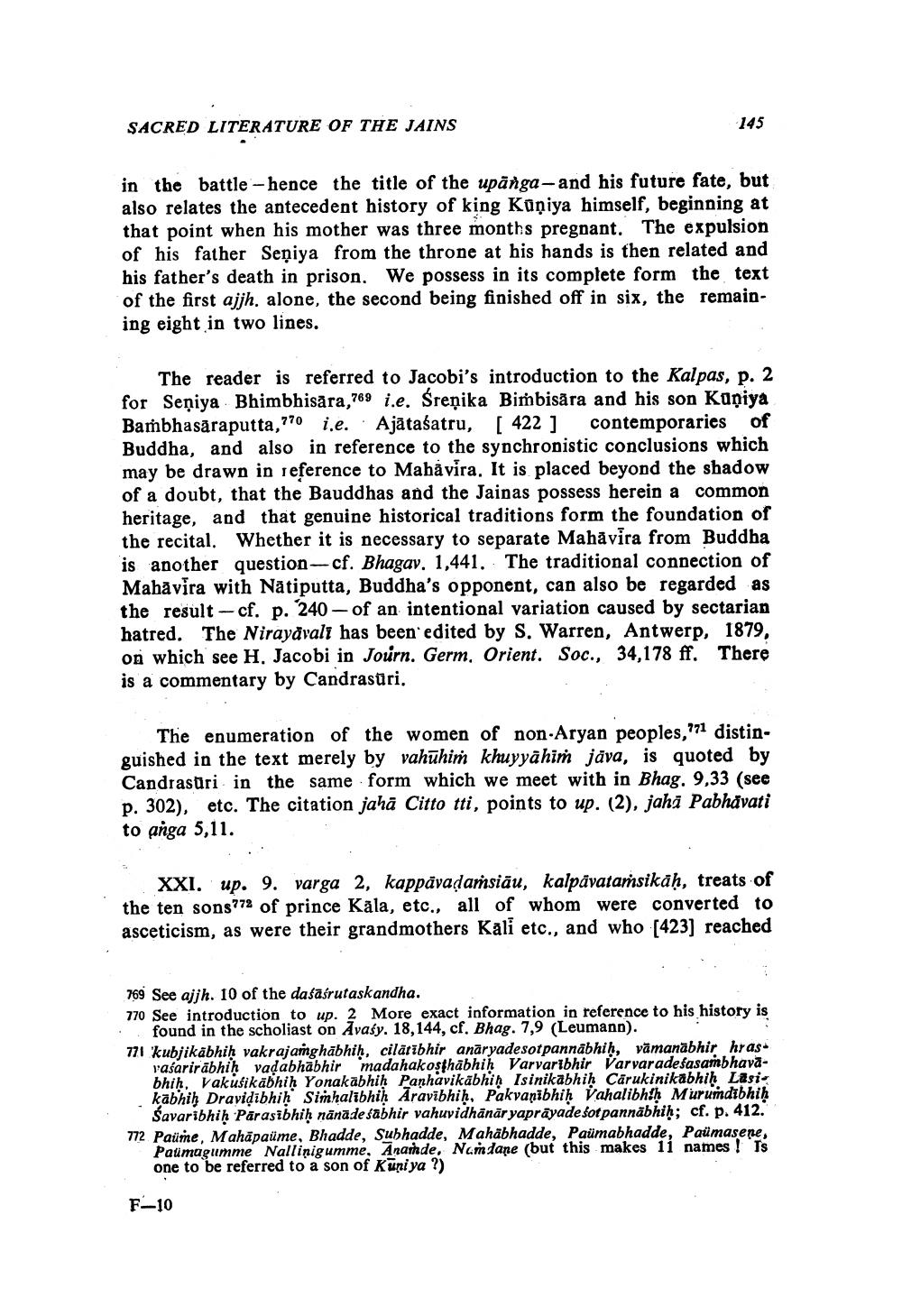________________
SACRED LITERATURE OF THE JAINS
145
in the battle - hence the title of the upanga-and his future fate, but also relates the antecedent history of king Kūņiya himself, beginning at that point when his mother was three months pregnant. The expulsion of his father Seņiya from the throne at his hands is then related and his father's death in prison. We possess in its complete form the text of the first ajjh. alone, the second being finished off in six, the remaining eight in two lines.
The reader is referred to Jacobi's introduction to the Kalpas, p. 2 for Seņiya Bhimbhisāra,769 i.e. Śreņika Bimbisāra and his son Kuniya Bambhasäraputta,770 i.e. 'Ajātaśatru, [ 422 ] contemporaries of Buddha, and also in reference to the synchronistic conclusions which may be drawn in reference to Mahāvira. It is placed beyond the shadow of a doubt, that the Bauddhas and the Jainas possess herein a common heritage, and that genuine historical traditions form the foundation of the recital. Whether it is necessary to separate Mahăvira from Buddha is another question --- cf. Bhagav, 1,441. The traditional connection of Mahavira with Natiputta, Buddha's opponent, can also be regarded as the result - cf. p. 240 — of an intentional variation caused by sectarian hatred. The Nirayavalı has been edited by S. Warren, Antwerp, 1879, on which see H. Jacobi in Journ. Germ. Orient. Soc., 34,178 ff. There is a commentary by Candrasuri.
The enumeration of the women of non-Aryan peoples, 771 distinguished in the text merely by vahūhim khuyyahiṁ jāva, is quoted by Candrasuri in the same form which we meet with in Bhag. 9,33 (see p. 302), etc. The citation jahā Citto tti, points to up. (2), jahi Pabhävati to anga 5,11.
XXI. up. 9. varga 2, kappavadarsiāu, kalpävatarsikāḥ, treats of the ten sons772 of prince Kāla, etc., all of whom were converted to asceticism, as were their grandmothers Kali etc., and who [423] reached
769 See ajjh. 10 of the daśāśrutaskandha. 770 See introduction to up. 2 More exact information in reference to his history is
found in the scholiast on Avašy. 18, 144, cf. Bhag. 7,9 (Leumann). 771 kubjikabhih vakrajamghābhih, cilātībhir anāryadesotpannābhih, vămanabhir hras.
vasarirābhih vadabhabhir madahakosthābhih Varvaribhir Varvaradeśasambhavabhih, Vakufikābhih Yonakabhih Panhavikābhih Isinikabhih Carukinikabhih Lasi. kābhih Dravidibhiḥ Simhalibhiḥ Aravibhiḥ, Pakvaņibhiḥ Vahalibhth Murundibhiḥ
Savaribhiḥ Parasibhiḥ nānāde sabhir vahuvidhānār yaprayadešot pannabhih; cf. p. 412. 772 Paüme, Mahāpaime, Bhadde, Subhadde, Mahābhadde, Paümabhadde, Paümasene,
Paumagumme Nallinigumme, Anaide, Nandane (but this makes 11 names ! Ts one to be referred to a son of Kuni ya ?)
F-10




